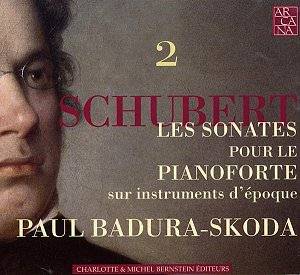|
|
Search MusicWeb Here |
|
 |
||
|
Founder:
Len Mullenger (1942-2025) Editor
in Chief:John Quinn
|
|
|
Search MusicWeb Here |
|
 |
||
|
Founder:
Len Mullenger (1942-2025) Editor
in Chief:John Quinn
|
 |
Franz SCHUBERT (1796-1828) Piano Sonatas, Volume 2 No. 3 in E major, D459 No. 4 in A minor, D537 No. 8 in F sharp major, D 571-604-570 No. 16 in C major, D845 No. 17 in D major, D 850 No. 18 in G major, D894 Recorded January 1993, Baumgartner Casino, Vienna; December 1993 Nos. 3 & 18), Institut Français, Vienna |
| CD available for post-free online mail-order or you may download individual tracks. For some labels you can download the entire CD with a single click and make HUGE savings. The price you see is the price you pay! The full booklet notes are available on-line. |  |
|
NOTE • Click on the button and you can buy the disc or read the booklet details • You can also access each track which you may then sample or down load. • Further Information. |
|
|
Schubert's piano sonatas are a significant part of his output, and Paul Badura-Skoda's recorded survey of them represents a significant contribution to the composer's discography as well as to our understanding of his unique musical development and style. What sets these performances apart from those of the celebrated artists who have been associated with Schubert - such as Wilhelm Kempff, Vladimir Ashkenazy, Clifford Curzon, Murray Perahia or, of an earlier generation, Artur Schnabel - is the instrument on which Badura-Skoda plays.
There are three different instruments on these CDs: two by Conrad Graf, from 1823 and 1826, and another that is earlier still, by Donath Schäfftos (1810). Therefore the tone quality of these performances is substantially different than we are likely to be familiar with in the Schubert sonatas. It is a mixed blessing, for this listener at least.
What is undoubtedly welcome is the freshness of rhythm and articulation which comes from the performer's chosen manner and from the timbre of each instrument. The early E major Sonata, D459, fares well from this scrutiny, and even the examination of a genuine Adagio movement at the heart of this four movement work is passed with conviction. The other piece in which the Schäfftos piano is used is a debatable compilation of incomplete extracts, described in the booklet as Sonata No. 8, but not that in reality. In fact the booklet numbering of the pieces is unreliable, and I have altered the listing to comply with the most up-to-date publication, the current R.E.D. catalogue. Most reliable of all is to refer to the Deutsche number at the end of each piece; then you cannot go wrong.
Sonata No. 8, to charitably describe it thus, in fact comes off quite well, and Badura-Skoda captures its fairly intimate manner in a performance of some conviction. Only the first movement raises significant doubts, its eight minutes seeming longer as the structure fails to convince. Admittedly this may have something to do with the tone quality of the instrument, of which more anon.
The pair of Graf pianos make for a more sophisticated range of colours, but still the tone of these instruments seems somewhat puny when compared with their more modern, more sophisticated counterparts. The recorded sound can also be rather close, and suffers from strain on the end of distortion in the final bars of D850, when Badura-Skoda makes a successful attempt to astonish with a display of virtuosity.
In the light of all this, it is inevitable that the greatest challenge to all concerned is found in the longest and most expressive movements, such as the Andantes of D845 and D850 and, most of all, the opening Molto moderato e cantabile of the D major Sonata, D894. In the latter case, especially, it seems likely that the jury will be out for a long time. Opinions will be divided over whether the limited timbres of the fortepiano can achieve the miracles of expressiveness and fluid lines that Schubert created. Supporters of the 'authenticity cause' will claim that such a sound was all Schubert knew; others will say that his imagination and technique surpass such limitations.
The answer, of course, has to be open-ended. But a three-CD set represents a big commitment for any collector ... Terry Barfoot See review Volume 1 by Kirk McElhearn
|
|
ADDITIONAL INFORMATION •
You can sample only 30 seconds (or 15% if that is longer) of a given track. Select from the View tracks list. Each sample will normally start from the beginning but you can drag the slider to any position before pressing play. • PLEASE NOTE: If you are behind a firewall and the sound is prematurely terminated you may need to register Ludwig as a trusted source with your firewall software.
•You will need Quicktime to hear sound samples. Get a free Quicktime download here • If you cannot see the "Sample All Tracks" button you need to download Flash from here.
|
|
|
Return to Index |